

A. A Basic Feature of Ritual Art: From Formality to Formalism
It is evident that Shinto liturgical rituals are formalized, elegant performances exhibiting aesthetically honed, repetitive patterns. A case in point is the basic action of bowing and clapping--a series of invariant, solemn gestures occurring several times in each ceremony. A more complex example is the appearance of the shrine's hall of offerings (heiden). It presents itself as an aesthetic object in several ways. It is a static, visual composition dominated by horizontals, sharply delineated designs of costumes and curtains, and the intersecting diagonals of bowed bodies.
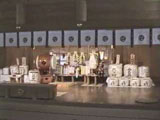 |
At the same time, it is the area in which offerings are precisely displayed, and the stage on which the priests move, chant, and drum with stylized deliberation.
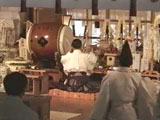 |
All this evinces order, rule, and structure.
One way to approach the family of aesthetic characteristics that we wish to highlight, is to imagine scoring such ritual performances, as anthropologists sometimes do. Here we intend a broad sense of score: any abstract notational system for displaying, in skeletal ideal form, the underlying structure of an object or event, usually an artwork or ritual. One could score a daily purification ritual, for example, using dance and acoustic or musical notations indicating the location of the priest and audience, his posture, movements, costume, and "stage setting;" and acoustically, the pitch, duration, and rhythm of the clapping, chanting and drumming. Even the visual composition of the priests, seated among the offerings on the raised platform, could be "scored" in geometric terms--horizontals, diagonals, and areas of contrasting color. To speak of scoring is to emphasize that rituals are repeated, highly structured, and more or less fixed sequences of events evincing many of the features of the visual and the performing arts.
The score, of course, does not match every aspect of the performance. For example, the clapping of the participants, led by the chief priest is often uneven, but the score would clearly indicate a certain number of equally spaced, synchronized claps.
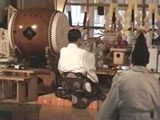 |
That is, scores not only display the structure of a performance, but they rely on a distinction between an idealized pattern and a concrete instance of the pattern. This has an experiential correlate: we are sometimes aware, as ritual participants, of trying to conform to an ideal pattern or sequence. Scoring such events invites distinctions akin to those between performance and script, or painting and geometric form. In the theory of fine arts, such distinctions come under the heading of formalism.
Formalism is an aesthetic theory peculiar to twentieth century Western art; but it is claimed by its adherents to reveal a universal, timeless, and culture-independent dimension of the arts. Whether or not those ambitious claims are true, we believe that art's formal dimension goes some way in explicating the connection between art and Shinto practices of purification. According to formalist doctrine, to perceive an artwork aesthetically is to attend to its formal qualities. These, in turn, are such features (speaking of the visual arts) as color, composition, texture, form and line. Formalism takes our attention away from the representational or narrative content of the work, its emotional effects, and its instrumental uses. It directs our attention to the way in which the artist has brought together formal elements.
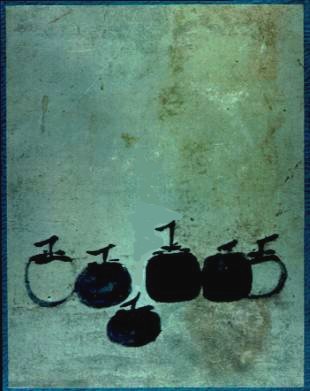 |
Six
Persimmons
by Mu-chi'i. |
On this view, the well-known brush painting by Mu-chi'i of six persimmons (casually arranged within an otherwise empty space) is justly famous because of the texture and line of the six images and their composition, not because persimmons are an inherently compelling subject. Even minor changes in the point of view or the spaces between the fruits will result in very different and generally inferior effects.
In addition, formalism not only directs our attention to such aesthetic dimensions as composition and color, but it further directs our attention to underlying structural relations such as geometric form or complementary relations among colors. With respect to music, it emphasizes intervals and harmonic structures, not just the melodic line.
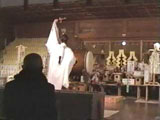 |
Formalism says, in effect, that what is most important about art is not its content but its grammar. In the evaluation of artworks, it is form that counts.
These structural features may not immediately be apparent to the casual viewer, but they are operative nevertheless as the source of the artwork's power to affect us aesthetically. Thus, formalism adds an important consideration to the above discussion of scoring. Not only can we distinguish in artworks and rituals between the particular instance and the underlying form; it is the latter that is claimed to account for their power. Formalism makes apparent that the priest's ability to successfully manipulate formal elements contributes to ritual efficacy.
Those who talk about art in formalist terms are often tempted to use the word "pure." There are works that exhibit pure form, and the contemplation of artworks involves a pure aesthetic gaze--a way of looking that involves setting aside the usual utilitarian concerns and striving to attend exclusively to the aesthetic qualities of the artwork. It follows that formalism is fiercely anti-instrumental. That an artwork expresses a political message, for example, is irrelevant to its aesthetic evaluation. Art is sometimes characterized, therefore, as divinely "useless," inhabiting a pure realm unsullied by utilitarian concerns. When we learn to perceive artworks, we learn to attend to their formal qualities and to suspend attention to other features such as representative content or didactic force. Trained musicians perceive the abstract pattern informing the sensuous sound of the performance. In fact, no adequate account of the powers of music can ignore the distinction between underlying structure, encoded in the score, and the physical event of the performance.
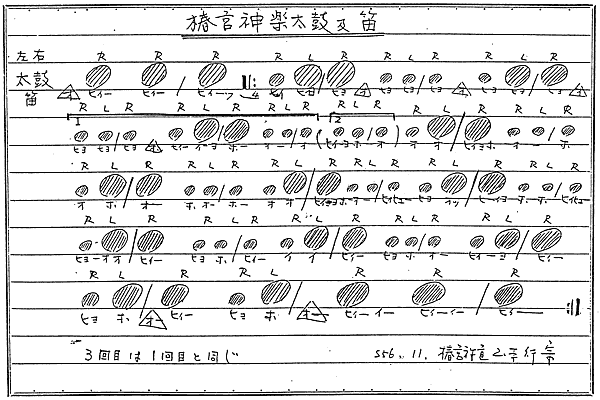 |
Score of drumming pattern. |
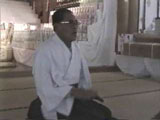 |
Yamamoto Yukimine demonstrating the rhythm of the score |
The importance of this distinction, for our purposes, is that the pattern enjoys a certain "perfection" and operates at something of a "distance" compared to the actual sounds. For example, the performance can be flawed while the pattern necessarily remains unblemished. So, due to the interplay of form with content, artworks are particularly efficacious means for evoking in us a sense of a pure structure separate from surface sensuous contents. These aesthetic distinctions are directly applicable to Shinto ritual, because as noted, these ceremonies display a rigorous formality. Hence, no matter what instrumental view one may bring to the ritual--e.g., that the offering are gifts to the kami to insure their blessings--it will be irrelevant to the formal power of the ritual performance itself.
Our point is that the deliberate, stylized quality of Shinto ritual brings to mind the distinction between pure form and particular shrine performances and that distinction can be further clarified by formalist aesthetic theory which reveals an essential and important power of art and of the ritual arts.
B. A Second Feature of Ritual Art: Liminal Efficacy
Another feature of Shinto rites is liminality. Like formality, it is one of the powers of the ritual arts which connects ritual to purification.
Some anthropologists, notably Arnold van Gennep and Victor Turner, claim to have uncovered a universal structure common to a certain class of transformative rituals such as rites of passage. Such rituals aim at changing the participants, either psychically or in terms of social status. For example, via rituals, adolescents become adults, and princes become kings. This view rests on a particular analysis of change. In order to become something new, one must first abandon the old, moving through a phase which is neither new nor old; only then can one achieve, accept, or construct the new. That middle phase of transformative rituals is called the liminal phase. It is characterized as "neither here nor there," or "betwixt and between," since it occurs between a phase of ritual separation from one's previous self or status and a phase of re-aggregation during which a new persona or status is produced and legitimized by the community. At its most general, liminality is thus a fluid phase promoting change. The ritual participant is like the checker piece, temporarily lifted off the board in a different (vertical) dimension, while being moved from one square to another. Our ability to create liminal situations by means of ritual is an important cultural discovery. It allows both the control and promotion of changes deemed worthwhile by the community.
For Turner, liminality involves temporarily setting aside or stripping away some or many of the features of societal interaction which govern daily life. This may be accomplished subtly, artfully and symbolically, or, in some ritual traditions, by means of suffering, cruelty, and violence (e.g., fasting, vision quests, or physical threat). Typically, the ritual participants are homogenized by finding themselves in a ritual space that de-emphasizes differences in social status, erases utilitarian concerns, and amends the sense of time. Turner explains this situation by appealing to Hume's notion of the sentiment of humanity--a basic and universal feature of human nature inclining us to community, but prior to all particular social structures. During the liminal phase, the participants are united by this sentiment, depending on a deeper sense of community temporarily unblemished by the usual, compromised and somewhat external social constraints. Turner labels this relationship "communitas."
Applying these notions to the Shinto tradition, it is those festivals that involve extreme physical effort or touch upon the sublime--e.g. Hadaka Matsuri (Naked Festivals)--that first come to mind.
 |
Konomiya Hadaka Matsuri |
The participants in such festivals may be temporarily transported to another realm of experience, often quite ambiguous and demanding. During these interludes, the usual conventions, demands, and distinctions of daily life recede into the background. One may emerge refreshed or otherwise transformed, and an experience of "communitas" may in fact occur among those actively engaged in the festival.
In a less dramatic way, the daily purification ritual in a shrine may also involve transformative moments. These more subtle and subdued liminal experiences can best be illuminated by the notion of a transforming journey and its associated images--death/rebirth, the womb, darkness or fog, bisexuality, eclipse, wilderness and emptiness. In myth, folktale, and literature, liminality is expressed by going under (e.g., Alice falling down the rabbit hole into Wonderland) or venturing forth into strange realms (Dorothy in the Land of Oz or Xuanzang's pilgrimage in his Journey to the West). In these realms, societal, physical, and even logical laws may be suspended. Such tales always show the protagonist before the journey into the liminal realm and, at the end, indicate her/his return--transformed--to ordinary life.
Similarly, each ritual encounter is something of a journey, beginning with entrance through the torii, ablutions at the temizuya, a walk to the shrine (which may involve a journey into the forest as well), entrance into the outer hall to experience various phases of the ceremony, and so on.
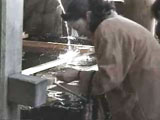 |
This "journey" may enhance the experience of distancing oneself from the dominant concerns of daily life.
Currently, liminality is claimed to be not only an important concept in ritual studies but also a widespread feature of the arts. In general, artworks can represent liminal experience or express its feeling tones, or produce something like liminal experience. The production of liminal experience can be illustrated by any powerful experience at the theater, for example, after which one has the impression of having been in a special realm (during the performance) and feels somehow changed.
A recent installation piece at a local fine arts museum provides a more detailed example. By means of a darkened hall, the viewers enter a room that seems completely without light. Gradually, however, a rectangular area on the opposite wall, the size and location of a large painting, becomes barely visible. It is apparently a uniformly black canvas, except that it seems in some way anomalous. As one approaches it, the space seems to be of indefinite but considerable depth and slightly undulating. Any viewer who ignores museum decorum and tries to touch the painting finds only space! This otherworldly "painting" is actually a rectangular hole cut in the far wall and opening onto another dark and empty room. The only light in either room is a black light on the floor of the second room and hidden from direct observation. The rectangular space, which is "neither here nor there," is a vivid representation and expression of liminality. It is also for some viewers productive of a liminal experience. Here we are taking liminal experience to be one kind of aesthetic experience--one that involves disorientation, ambiguity, and a sense of otherness.
A related example is the inner sanctuary (gohonden) of a shrine, an "empty" box in the innermost worship hall that enshrines or invites the kami and at the same time exemplifies the enigmatic ontological status of kami which exceeds all attempts at definition.
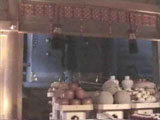 |
In its ability to represent and express an ambiguous and otherwordly state or process, the empty box functions much like the dark empty room described above. But, of course, there is an important difference: since the emptiness at the heart of the shrine is generally hidden from view, this "liminality" functions as an image of the imagination rather than a visual image.
Note that though liminality may depend for its efficacy upon the formal features of rituals-as-artworks, it is not to be confused with those features. Liminality is not a grammatical feature of artworks, but a phase in certain kinds of ritual, and an experience induced by some artworks--a phase or experience best described phenomenologically in terms of its experiential and social effects. However, since liminality is a distinct and widespread power of ritual and art, and since it creates an extra-mundane effect, it shares with formal features qualities relevant to the relationship between ritual art and purification--a point we are now in a position to discuss.
Jump to: Introduction | Part I | Part III | About the Authors